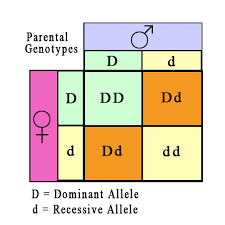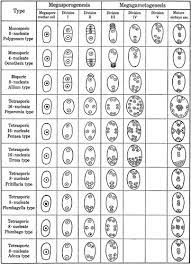Linkage - principles, types, arrangement of linked genes, significance, linkage group, factors affecting linkage
Linkage
Linkage is defined as the tendency of two or more genes to
remain together in the original combination in the same chromo some during the
process of inheritance for a number of generations. All the genes on a
chromosome are said to be linked to one another.
Linkage was discovered by T.H. Morgan. Linkage was found in
Drosophila, sweet peas, maize, man, etc. In Drosophila, the genes of body
colour and nature of wings are linked and located on the same chromosome. In
sweet pea, the genes of flower colour and size of pollen grains are linked. In
maize, the genes for colour and shape of seeds are linked. In man, linked. The genes
for haemophilia and colour blindness are linked.
Principles of linkage:
T.H. Morgan (1911) proposed the theory of linkage based on
his experiments in Drosophila. The theory of linkage explains the main
principles of linkage. They are the following:
1. A chromosome contains many genes.
2. The genes are arranged in a linear fashion on the chromosomes.
3. The genes present in a chromosome are linked.
4. The linked genes are inherited together from the parents
to the offspring.
5. Linkage is a rare phenomenon when compared to crossing
over.
6. The strength of linkage depends on the distance between
the linked genes. Closely located genes show strong linkage. Widely located
genes show weak linkage.
7. Mendel's law of independent assortment is not universal.
8. The linked genes do not show independent assortment. The
genes located on different chromosomes only show independent assortment.
9. When dominant genes are located on one homologous chromosome
and the recessive genes on the other homologous chromo some, the arrangement of
linked genes is called cis arrangement. When the dominant and recessive genes
are linked in one chromosome, the arrangement is called trans arrangement.
10. All the linked genes of a homologous pair of chromosome
constitute one group called linkage group. The number of linkage group in an
organism is equal to the number of pairs of chromosomes. Thus Drosophila has 4
linkage groups as it has 4 pairs of chromosomes. Pea plant has 7 linkage groups
as it has 7 pairs of chromosomes. Man has 23 linkage groups as he has 23 pairs
of chromosomes.
11. Linkage is of two types, namely complete linkage and
incomplete linkage. In complete linkage, the chromosomes do not break and the
linked genes inherit together for many generations. Eg. F1 male Drosophila. In
incomplete linkage, the chromosomes break occasionally and the linked genes
separate due to crossing over. Eg. F1 female Drosophila.
Types of Linkage:
Linkage is of two types, namely complete linkage and incomplete
linkage.
1. Complete Linkage
In complete linkage, linked genes inherit together for many
generations. Here crossing over does not occur. In complete linkage the genes
are closely situated.
Eg. 1. Body colour and shape of wings in male Drosophila.
2. Bent wings and shaven bristles in the 4th chromosome of
Drosophila.
Complete linkage is the phenomenon in which two or more
genes or characters are inherited together for a number of generations. In
this, genes are closely associated and tend to inherit together. Complete linkage
is due to the fact that there occurs no break in the chromosomes. As a result
of complete linkage, the young ones inherit only the parental characters. New
characters do not appear among the young ones. So complete linkage produces
only parental combination; new combinations do not arise. This phenomenon is
very rare. It is found only in male Drosophila. The F1 male hybrid is back
crossed with recessive female parent. The F1 male hybrid produces only two
types of gametes in which the linked genes (G and L or g and) are inherited
together. So only two types of offspring are produced in the F2 generation in
equal numbers.
2. Incomplete Linkage:
The separation of
linked genes during inheritance is called incomplete linkage. The linked genes
are separated due to crossing over, chromosomal breaks, etc.
Eg. 1. Body colour and wing shape in female Drosophila.
2. Seed colour and
seed shape in maize.
3. Flower colour and pollen grain shape in sweet pea.
In incomplete linkage, the linked genes on certain occasions separate. This leads to the formation of new combinations among the young ones. Incomplete linkage is due to the breakage of chromosomes during gametogenesis. Incomplete linkage is found in female Drosophila. This breakage of chromosomes leads to the separation of linked genes and new combinations appear. Because of this new genic com bination the offspring produced in the F2 generation are different from their parent in their phenotype and genotype. So the incomplete linkage involves the accidental breakage of chromosomal segments of linked genes, resulting in new combination of genes. In the below experiment, the F1 female hybrid produces four types of gametes. Among four types, two types of gametes carry new combinations due to the separation of linked genes. The gene G is separated from L and joins with 7. In the same way the L joins with g. These combinations are different from the original combination. This type of inheritance is different from the independent assortment. If the genes are assorted independently the four types of offspring produced in the F2 generation of the above experiment should be in the 1:1:1:1 ratio.
Arrangement of Linked Genes:
Sturtevant in 1913 found out that the genes are arranged in
the chromosome in a linear manner. Based upon the arrangement of the genes in
the chromosome the linkage can be classified into two types.
1. Cis arrangement:
In cis arrangement,
the two dominant genes (B and L) are located on one member of the chromosome
pair; the two recessive genes (band 1) are located on the other. This type of
arrangement, with two dominants on same chromosome is called cis arrangement.
The heterozygotes with such arrangement are known as cis heterozygotes.
2. Trans arrangement:
In this type, the dominant gene of one pair and the recessive gene of other pair. (B and I) are located on one chromosome and the recessive gene of the first pair and dominant gene of the second pair (b and L) are located in the second chromo some. The heterozygotes with such arrangement are known as transheterozygotes.
Importance of Linkage:
1. Linkage presents variation in evolution.
2. Linked genes of desired traits help the plant and animal
breeders in hybridization programs.
Linkage Groups:
All the linked genes of a homologous pair of chromosomes form one group called linkage group. In Drosophila, there are four linkage groups corresponding the four pairs of chromosomes. The garden pea plant has seven pairs of chromosomes and has 7 linkage groups. Man has 23 linkage groups corresponding to 23 pairs of chromosomes. Each linkage group has a particular number of genes. The number of genes is proportional to the length of the chromosomes. In Drosophila, the smallest chromosome has the smallest link age group of 12 linked genes. The largest chromosome has the largest linkage group of 150 linked genes.
Factors Affecting Linkage:
Linkage is affected by the following factors:
1. Distance:
Closely located genes show strong linkage while
genes widely located show weak linkage.
2. Age:
With increasing age the strength of linkage
decreases.
3. Temperature:
Increasing temperature decreases the
strength of linkage.
4. X-rays:
X-ray treatment reduces the strength of linkage.
Reference:
Gentics by R.P.Meyyan - saras publication
Gentics by P.S.verma and V.K.aggarwal - s.chand publication







Comments